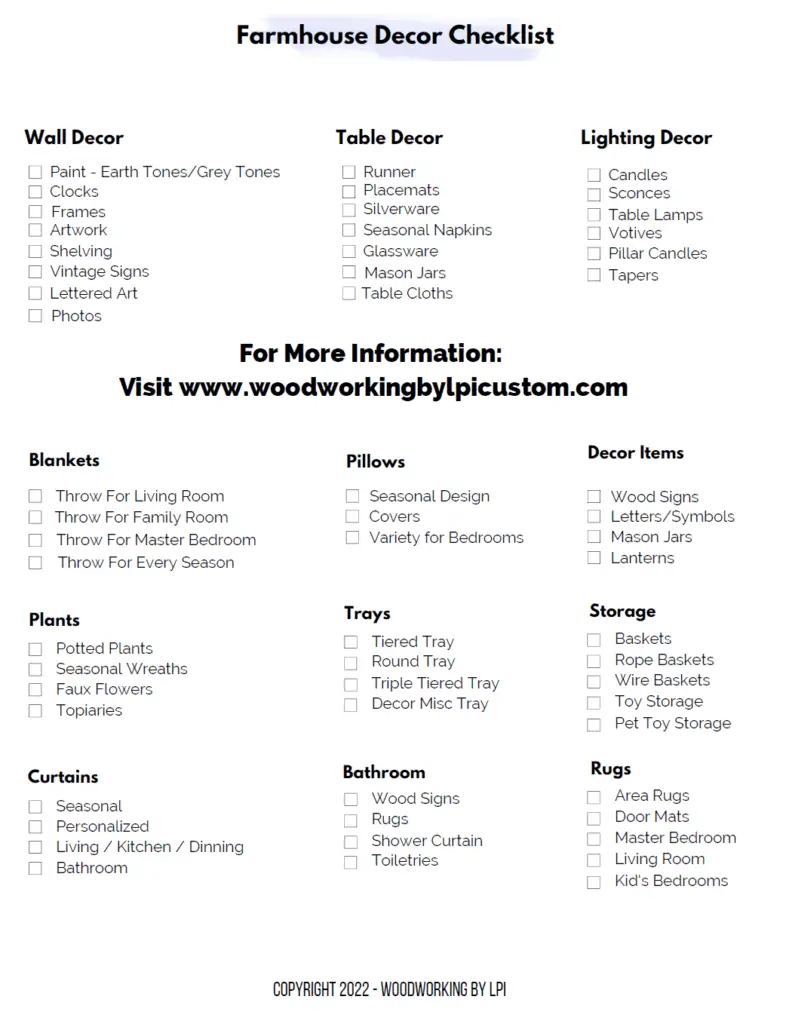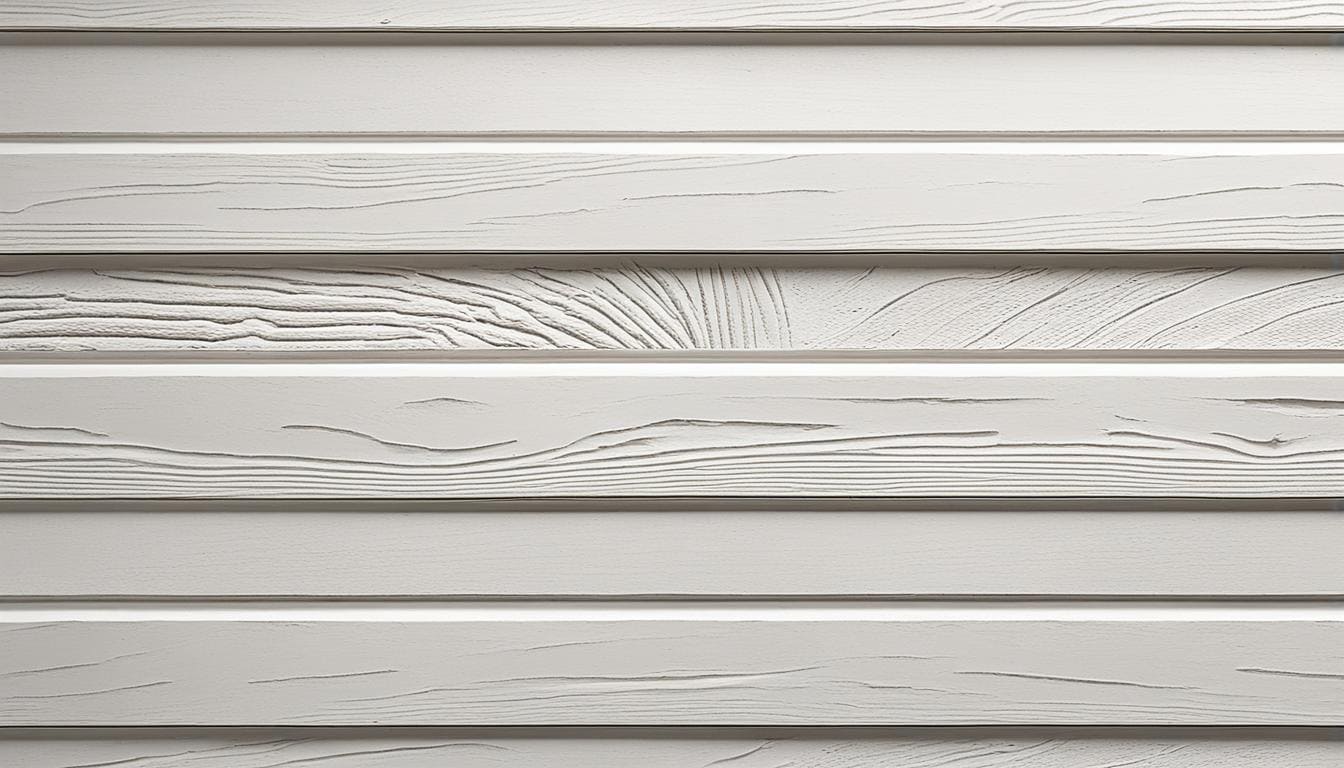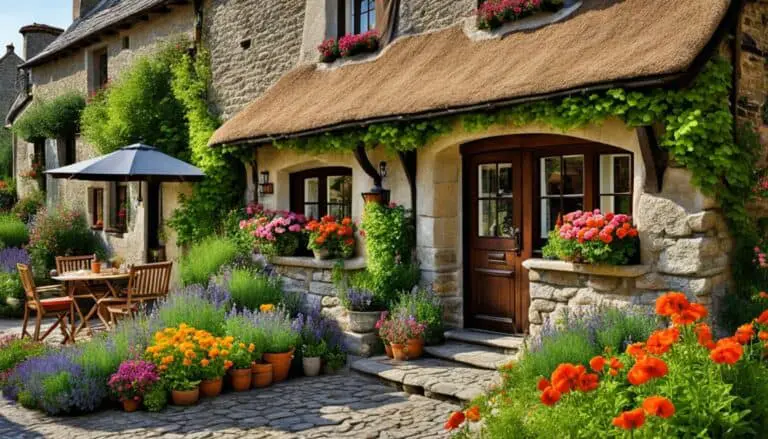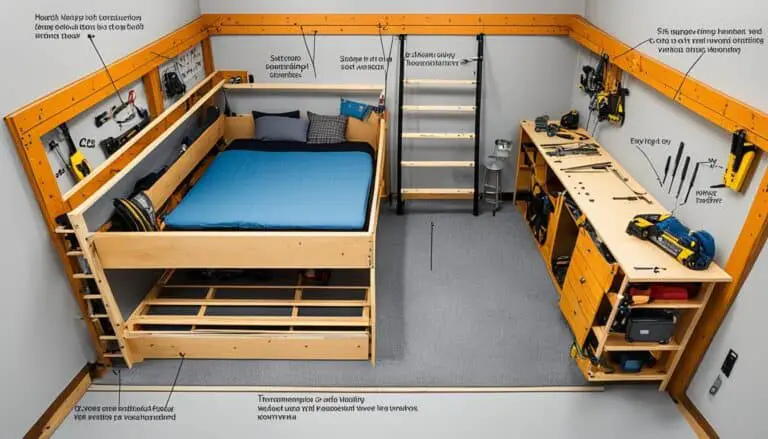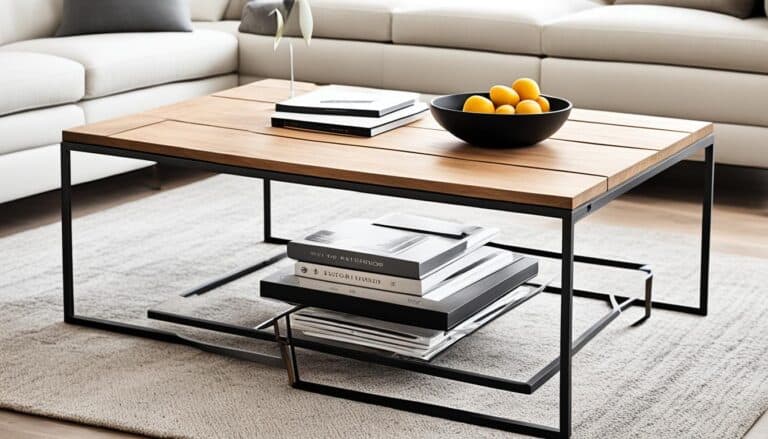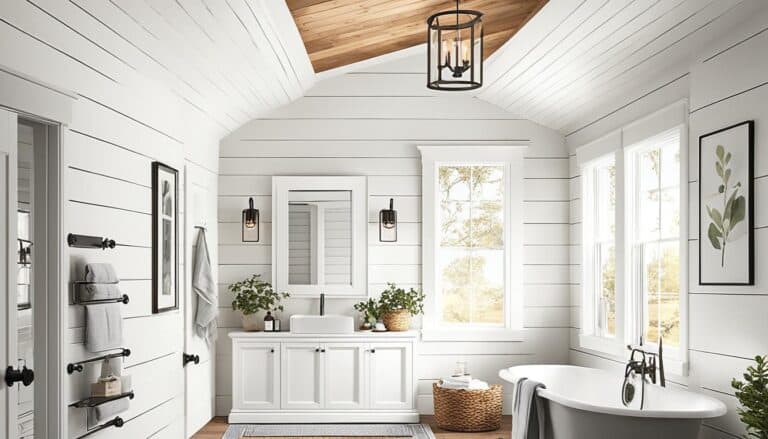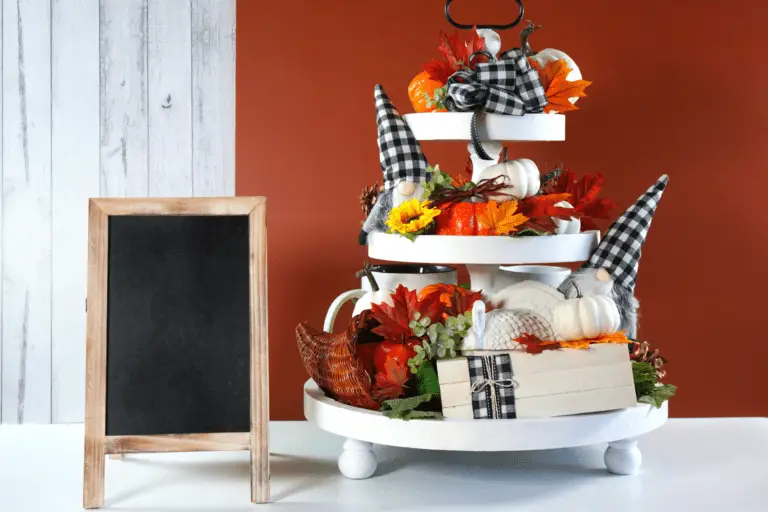Introduction
Welcome to our comprehensive style guide on board and batten, a design trend that can elevate the aesthetic of your home. Have you ever wondered how to add character and charm to your living space? How can you achieve a unique and timeless look that stands out from the crowd? Brace yourself, because we are about to unveil the secrets of board and batten style!
Board and batten is not just an ordinary home improvement technique; it is a game-changer. From interior design to exterior renovations, this versatile style has captured the attention of homeowners and designers alike. But what sets it apart? What makes it so special? Let us take you on a journey to discover the beauty and versatility of board and batten, and how it can transform your home into a stunning masterpiece.
Key Takeaways:
- Board and batten is a design trend that can elevate the aesthetic of your home.
- This style adds character, charm, and a unique look to your living space.
- Board and batten is versatile, capturing the attention of homeowners and designers.
- Discover the beauty and versatility of board and batten through our comprehensive style guide.
- Transform your home into a stunning masterpiece with board and batten.
Introduction to Board and Batten
Board and batten is a timeless design technique that can add both character and charm to the interior and exterior of your home. Whether you’re looking to spruce up your living space or enhance your home’s curb appeal, board and batten offers a versatile and visually appealing solution. In this section, we will provide an overview of board and batten, exploring its uses in both interior and exterior design.
Unveiling the Charm: What is Board and Batten?
In this section, we will delve into the historical significance of board and batten and how it has evolved over time. From its origins as a practical siding option to its current status as a popular design trend, you will discover the rich history behind this timeless style.
Historical Significance of Board and Batten
The board and batten style has a long-standing history that dates back centuries. Originally used as a functional siding technique, it offered protection against the elements for buildings and structures. The technique involves the use of alternating wide boards (the “boards”) and narrower vertical battens to create a visually appealing and sturdy facade.
This style originated in Northern Europe and was brought to the Americas with the European settlers. It was widely utilized in early American architecture, particularly in traditional barns and farmhouses. Board and batten quickly gained popularity not only for its practicality but also for its rustic and charming appeal.
Today, board and batten retains its historical significance and is often associated with traditional and farmhouse-style homes. Its enduring popularity speaks to its ability to add character and warmth to any space.
The Modern Adaptation of Board and Batten Design
“The board and batten style has evolved from its humble beginnings as a functional siding option to a versatile design element that can be incorporated into various architectural styles and settings.”
While the board and batten style has deep historical roots, it has also undergone a modern adaptation to suit contemporary design trends. Architects and designers have embraced this style, using it to create visual interest and texture both indoors and outdoors.
Modern board and batten designs often feature sleek and clean lines, with the battens spaced evenly and wider board sizes to achieve a more refined and contemporary look. This style has expanded beyond traditional settings and can now be seen in urban townhouses, modern farmhouses, and even commercial spaces.
The versatility of board and batten design allows it to be used as a complete siding solution or as an accent feature on specific areas of a building. It can transform a plain facade into a visually appealing architectural element, bringing depth and character to any structure.
| Historical Significance | Modern Adaptation |
|---|---|
| Originated as a practical siding option Widely used in traditional American architecture Known for its rustic and charming appeal | Adapted to suit contemporary design trends Incorporated into various architectural styles Offers versatility and visual interest |
Crafting the Look: Board and Batten Design Principles
When it comes to elevating the aesthetic of your home, board and batten design principles play a crucial role. This timeless style, characterized by the alternating use of wide vertical boards (boards) and narrow strips (battens), can transform the look of any space. In this section, we will explore the design principles of board and batten and how they can enhance the visual appeal of your home.
The Aesthetic Appeal of Vertical Lines
One of the key factors that make board and batten design visually appealing is the use of vertical lines. These lines draw the eye upward, creating an illusion of height and making the space feel more spacious. The verticality of board and batten also adds a sense of elegance and sophistication while providing a visually interesting texture to the walls.
Whether you choose to incorporate board and batten in your interior or exterior design, the vertical lines will undoubtedly be a focal point. They can be emphasized further by using contrasting colors or finishes, adding depth and dimension to your space.
Additionally, vertical lines can also be used strategically to accentuate architectural features or to create visual harmony with other elements in your home. For example, installing board and batten on an accent wall can draw attention to a fireplace, a piece of artwork, or a stunning view.
Choosing the Right Materials for Your Design
When it comes to board and batten, material selection plays a crucial role in achieving the desired look and ensuring the durability of your design. The choice of materials should be based on factors such as your budget, climate considerations, and the overall design style you wish to achieve.
Wood is a popular choice for board and batten because of its natural beauty and versatility. You can opt for traditional options such as cedar or pine, which offer a timeless appeal and are well-suited for both interior and exterior applications. Alternatively, engineered wood products like Medium Density Fiberboard (MDF) provide a cost-effective and environmentally friendly option.
For an even wider range of design possibilities, you can explore composite materials that mimic the look of wood while offering enhanced resistance to rot, warping, and insect damage. These materials can be a great choice for areas with high moisture or extreme weather conditions.
Ultimately, the material you choose should align with your desired aesthetic, budget, and maintenance preferences. Whether you prefer the natural warmth of wood or the durability of composite materials, selecting the right materials is essential in achieving a board and batten design that stands the test of time.
The DIY Approach: Board and Batten Installation Basics
Are you ready to take on a rewarding home improvement project? In this section, we will guide you through the step-by-step process of installing board and batten on your own. With our comprehensive DIY guide, you’ll gain the knowledge and confidence to tackle this project and elevate the look of your home.
Before you begin, it’s essential to plan and measure your space accurately. Assess the area where you want to install board and batten and determine the dimensions and layout that best suit your design vision. Once you have your measurements, gather the necessary tools and materials.
- Materials needed:
- Wood/MDF strips
- Wood screws/nails
- Construction adhesive
- Spackle or wood filler
- Sanding block or sandpaper
- Paint or stain
- Paintbrush or roller
- Tools required:
- Tape measure
- Level
- Miter saw or circular saw
- Power drill or hammer
- Sawhorses or workbench
- Safety goggles and gloves
Once you have all your materials and tools ready, it’s time to proceed with the installation. Follow these steps:
- Start by locating and marking the studs on your wall. This will provide a secure anchor for the boards.
- If desired, install a baseboard or chair rail before proceeding with the board and batten installation.
- Cut your wood or MDF strips to the desired length using a miter saw or circular saw. Remember to account for any corners or angles in your design.
- Apply construction adhesive to the back of each strip and press them firmly onto the wall, ensuring they are level and plumb.
- Secure the strips with wood screws or nails, making sure to drive them into the studs. Use a countersink drill bit for a flush finish.
- Fill any screw or nail holes with spackle or wood filler, and sand them smooth once dry.
- Apply a coat of paint or stain to your board and batten, following the manufacturer’s instructions. For a durable and professional finish, use a paintbrush or roller.
Congratulations! You have successfully installed board and batten on your own. Step back and admire the transformation of your space. Now, your home exudes a timeless charm and character.
Remember, patience and attention to detail are key when installing board and batten. Take your time, measure accurately, and ensure each board is securely fastened. The result will be a stunning addition to your home that you can proudly showcase to friends and family.
Choosing Wood/MDF Strips: The First Step in Your DIY Journey
The selection of the right wood or MDF strips is crucial for the success of your board and batten project. In this section, we will guide you through the process of choosing the optimal width and quality of the strips, as well as finding straight boards for a flawless finish.
Selecting the Optimal Width and Quality
When it comes to board and batten materials, you have the option of using either wood strips or MDF strips. Wood strips offer a natural and rustic look, while MDF strips provide a more affordable and consistent alternative.
For the width of the strips, it largely depends on your personal preference and the style you want to achieve. Generally, narrower strips (around 2-3 inches) create a more traditional and refined look, while wider strips (around 4-6 inches) lend themselves to a bolder and more modern aesthetic. Consider the proportions of your walls and the overall design scheme of your home when making this decision.
In terms of quality, it is essential to choose strips that are free from defects, such as knots or warping. Inspect each strip carefully to ensure they are straight, smooth, and free from any imperfections. Opting for high-quality materials will not only provide a better end result but also ensure the longevity of your board and batten installation.
Finding Straight Boards for a Flawless Finish
Working with straight boards is crucial for achieving a smooth and professional-looking board and batten finish. Here are a few tips to help you find straight boards:
- Inspect each board visually to ensure it is straight and free from any warping or bowing.
- Run your hand along the length of the board to feel for any irregularities or bumps.
- Place the board on a flat surface and check if it rests evenly without rocking or wobbling.
- Avoid boards with excessive knots, as they can affect the stability and appearance of the finished project.
By taking the time to select and find straight boards, you can ensure a flawless and professional-looking board and batten installation.
Creating Your Board and Batten Wall: A Step-by-Step Tutorial
Now that you have a clear understanding of board and batten design principles, it’s time to bring your vision to life. In this section, we will provide you with a detailed step-by-step tutorial on how to create your board and batten wall. From measuring and drawing your design to important considerations for textured walls and achieving a smooth finish, we’ve got you covered.
Before you begin, gather all the necessary tools and materials:
- Wood or MDF strips
- Nails or screws
- Measuring tape
- Pencil
- Level
- Saw
- Spackle or wood filler
- Sandpaper
- Paint or stain
- Paintbrush or roller
Now, let’s jump into the tutorial:
Planning Your Design: Tips for Measuring and Drawing
- Start by measuring the wall where you plan to install the board and batten. Take accurate measurements for both the length and height of the wall.
- Using a pencil and a level, mark the desired height of your board and batten on the wall. This will serve as a guide for the installation process.
- Next, measure the width of each board or batten strip you will be using. It’s essential to ensure consistent spacing between each strip for a visually pleasing result.
- With the help of a measuring tape and level, draw vertical lines on the wall to indicate the placement of each board or batten strip. These lines will serve as a guide during installation.
Remember to step back and assess the design before proceeding to the next step. A well-planned design is key to achieving the desired visual impact.
Key Considerations for Textured Walls and Smooth Finishes
If you have textured walls, there are a few additional considerations to keep in mind:
- Choose thinner board or batten strips to accommodate the texture and ensure a flush installation.
- Before attaching the strips, fill any gaps or uneven areas on the wall with spackle or wood filler. Sand it down to create a smooth surface.
- Once the wall is prepared, proceed with the installation as per the tutorial above.
If you prefer a smooth finish, follow these steps:
- Apply a thin layer of spackle or wood filler to the wall, covering any imperfections or texture. Allow it to dry completely.
- Sand the wall to create a smooth surface. Use fine-grit sandpaper for optimal results.
- Wipe away any dust or debris from the sanding process.
- Continue with the tutorial above to install your board and batten strips.
Congratulations! You have successfully completed the planning and preparation phase for your board and batten wall. The next steps will guide you through the installation process, bringing your design to life.
Board and Batten Siding: Combining Functionality and Beauty
When it comes to enhancing the exterior design of your home, board and batten siding offers a unique blend of functionality and beauty. This section will explore the use of board and batten as siding for your home’s exterior, discussing its durability, functionality, and the aesthetic benefits it brings to your home’s curb appeal.
Board and batten siding is known for its distinct vertical pattern, created by alternating wide boards (boards) with narrow strips (battens). This design creates a visually striking look that adds depth and character to your home’s exterior.
One of the key benefits of choosing board and batten siding is its durability. It provides a protective barrier against the elements, helping to shield your home from wind, rain, and other weather conditions. This siding option is sturdy and long-lasting, ensuring that your home remains well-protected for years to come.
In addition to its functional properties, board and batten siding also brings a sense of timeless beauty to your home. The vertical lines create a sense of height and elegance, making your home stand out in the neighborhood. Whether you have a traditional or modern design aesthetic, board and batten siding can be customized to suit your style.
Furthermore, board and batten siding allows for creative expression in exterior design. You can choose from a variety of materials, including wood, vinyl, or fiber cement, each offering its own unique look and benefits. The wide range of color options available ensures that you can find the perfect combination to complement your home’s overall aesthetic.
To get a better idea of the visual impact and versatility of board and batten siding, take a look at the image below:
Whether you want to enhance the charm of a cottage-style home or add a modern twist to a contemporary design, board and batten siding is a versatile option that can transform the look and feel of your home’s exterior.
Next, we will explore the various materials available for board and batten siding, as well as the impact of material choice on project cost. Stay tuned for the next section to learn more!
Board and Batten Materials: Durability and Cost-Effectiveness
In order to bring your board and batten design to life, it’s important to choose the right materials that not only offer durability but also remain cost-effective. In this section, we will explore different material options for board and batten and discuss their pros and cons, helping you make an informed decision for your project.
Exploring Material Options for Board and Batten
When it comes to board and batten, there are several material options available, each with its own unique characteristics. Here are some popular choices:
- Wood: Wood is a classic choice for board and batten, offering a natural and timeless appeal. It is versatile, easy to work with, and can be stained or painted to match your desired look. However, wood may require regular maintenance to protect it from weathering.
- MDF (Medium-Density Fiberboard): MDF is a composite material that is often used as a cost-effective alternative to wood. It is resistant to warping and has a smooth surface, making it ideal for achieving a flawless finish. However, MDF is not as durable as wood and may not be suitable for exterior applications.
- PVC (Polyvinyl Chloride): PVC board and batten is highly durable and resistant to moisture, making it an excellent choice for exterior applications. It requires minimal maintenance and is available in a variety of colors. However, PVC may not offer the same natural aesthetic as wood or MDF.
These are just a few examples of the materials you can choose for your board and batten project. By considering factors such as aesthetics, durability, and maintenance requirements, you can choose the material that best suits your needs.
The Impact of Material Choice on Project Cost
When planning your board and batten project, it’s important to consider the impact of material choice on the overall cost. While wood may offer a desirable aesthetic, it can be more expensive compared to MDF or PVC. On the other hand, opting for lower-cost materials like MDF or PVC can help you achieve a similar look while keeping the project cost-effective. However, it’s essential to factor in long-term maintenance costs and the potential need for replacement in the future.
Overall, when deciding on the materials for your board and batten project, weigh the benefits of each option against your budget and long-term goals. By carefully considering material options and their cost-effectiveness, you can create a stunning board and batten design that stands the test of time.
Enhancing Your Home’s Exterior with Board and Batten Siding
Board and batten siding is a fantastic way to elevate the exterior design of your home while also making significant home improvements. With its timeless appeal and design versatility, board and batten siding offers numerous benefits that can transform the look and feel of your house.
Board and Batten Siding Benefits
When it comes to enhancing your home’s exterior, board and batten siding has several advantages:
- Increased Curb Appeal: Board and batten siding adds visual interest and a touch of charm to your home’s facade, creating an eye-catching exterior that stands out.
- Durability: Designed to withstand the elements, board and batten siding is durable and long-lasting, providing protection and structural integrity for your home.
- Low Maintenance: With its simple yet elegant design, board and batten siding requires minimal upkeep, saving you time and effort on maintenance tasks.
- Energy Efficiency: The design of board and batten siding allows for better insulation, reducing energy costs and creating a more comfortable living environment.
- Versatile Design: Whether your home is modern, traditional, or anything in between, board and batten siding offers design versatility that complements various architectural styles.
With these benefits in mind, it’s clear that board and batten siding can have a significant impact on the overall look and functionality of your home.
Design Versatility and Creative License
One of the greatest advantages of board and batten siding is its design versatility, providing homeowners with endless possibilities for creating a unique and personalized exterior. The clean lines and distinctive pattern of board and batten allow for creative expression and the opportunity to customize the look of your home.
Whether you prefer a classic and timeless aesthetic or a more contemporary and modern design, board and batten siding can adapt to your style preferences. It can be used to highlight architectural features, accentuate specific areas of your home, or even transform the entire exterior for a cohesive and cohesive look.
Furthermore, board and batten siding allows for experimentation with color choices and finishes. You can opt for a bold and vibrant color scheme to make a statement, or choose subtle hues for a more understated elegance. The flexibility of board and batten siding enables you to infuse your personality and creativity into your home’s exterior design.
With so many design possibilities, board and batten siding truly gives you the creative license to make your home stand out in the neighborhood.
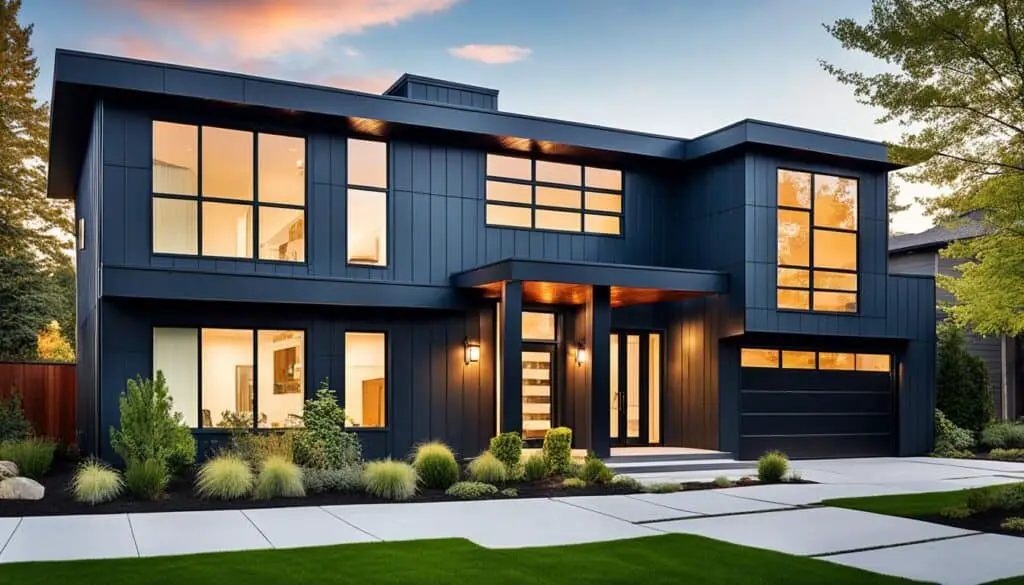
By incorporating board and batten siding into your home’s exterior, you can achieve a stunning transformation that not only enhances curb appeal but also reflects your personal style. From its numerous benefits to the design versatility it offers, board and batten siding is an ideal choice for any homeowner looking to make a statement with their home’s exterior design.
Optimizing Your Home’s Curb Appeal with Board and Batten
When it comes to enhancing the exterior of your home, board and batten can make a significant impact on its curb appeal. By incorporating this classic design element, you can transform your home’s façade into a visually appealing and cohesive space. Here are some tips and ideas to help you optimize your home’s curb appeal with board and batten:
1. Architectural Details: Utilize board and batten to accentuate architectural features such as gables, dormers, or columns. This will add depth and visual interest to your home’s exterior.
2. Color Contrast: Choose contrasting colors for your board and batten design to create a striking visual effect. For example, consider pairing light-colored siding with dark-toned battens or vice versa.
3. Landscaping Integration: Integrate board and batten into your landscaping design by incorporating it into fences, pergolas, or trellises. This will help create a seamless transition between your home and outdoor space.
4. Front Porch Upgrade: Apply board and batten to your front porch area to create a welcoming entrance. This can be achieved by installing it as cladding on porch posts or as decorative panels on the porch walls.
5. Window Treatments: Frame your windows with board and batten to enhance their visual appeal. The addition of battens around windows can provide a neat and finished look to your home’s exterior.
6. Exterior Lighting: Install outdoor lighting fixtures strategically to highlight the board and batten design. This will not only showcase its beauty during the nighttime but also add an extra layer of security to your home.
Remember, board and batten is a versatile design element that can be customized to suit your unique style and preferences. By following these tips and exploring various board and batten ideas, you can enhance your home’s curb appeal and create a visually stunning exterior.
Maintaining Your Board and Batten Addition: Tips and Techniques
Proper maintenance is crucial to ensure the longevity and appearance of your board and batten addition. By following these tips and techniques, you can preserve the beauty and functionality of your board and batten design for years to come.
The Importance of Proper Caulking and Wood Filler Application
Caulking and wood filler play a critical role in maintaining the integrity of your board and batten installation. Here’s why:
- Waterproofing: Caulk acts as a barrier against moisture, preventing water from seeping behind the boards and causing damage.
- Sealing Gaps: Proper caulking fills gaps and cracks, ensuring a seamless and professional-looking finish.
- Preventing Decay: Wood filler is used to repair any damaged or decaying sections, preventing further deterioration.
When applying caulking and wood filler, follow these best practices:
- Clean and Dry: Ensure the surface is clean and dry before applying caulking or wood filler to achieve maximum adhesion.
- Choose the Right Product: Select a high-quality caulking and wood filler suitable for exterior applications to ensure durability.
- Apply Evenly: Use a caulk gun or putty knife to apply caulking and wood filler, ensuring an even and uniform application.
- Smooth and Blend: Smooth out the caulking and wood filler with a tool or damp cloth to create a seamless finish that blends with the surrounding surface.
Best Practices for a Durable Finish
Creating a durable finish is essential for protecting your board and batten addition from the elements. Consider the following tips:
- Priming and Painting: Apply a high-quality primer before painting to enhance adhesion and ensure a long-lasting finish.
- Choose the Right Paint: Select a paint specifically formulated for exterior use, offering resistance to fading, cracking, and peeling.
- Regular Cleaning: Regularly clean your board and batten feature using mild soap and water to remove dirt, dust, and other debris.
- Inspect and Repair: Periodically inspect your board and batten installation for any signs of damage or wear. Promptly repair any issues to prevent further deterioration.
By following these maintenance tips and techniques, you can keep your board and batten addition in optimal condition, ensuring its beauty and functionality for years to come.
Board and Batten for Different Home Styles: Modern to Traditional
Incorporating board and batten into your home design can add a touch of elegance and charm. This section explores how board and batten can be incorporated into different home styles, from modern farmhouse designs to traditional applications.
Incorporating Board and Batten in Modern Farmhouse Design
If you’re looking to create a modern farmhouse aesthetic, board and batten is a perfect choice. The clean lines and vertical orientation of board and batten siding complement the simplicity and rustic appeal of a modern farmhouse. Pair it with a neutral color palette and natural materials such as wood or stone, and you’ll achieve the quintessential modern farmhouse look.
Traditional Applications of Board and Batten
Board and batten is a classic siding option that has been used for centuries in traditional architecture. Whether you have a Cape Cod-style home, a cottage, or a colonial revival, board and batten can enhance the character and charm of these traditional designs. By maintaining the historical details and color schemes, board and batten can seamlessly blend in with the existing architectural style.
By utilizing board and batten siding and design elements, you can transform your home into a modern farmhouse or retain its traditional charm. The versatility and timeless appeal of board and batten make it a popular choice for homeowners looking to elevate their home’s design.
Choosing Color Schemes for Board and Batten Features
Incorporating the right color scheme is key to creating beautifully cohesive board and batten features that enhance the overall aesthetic of your home. In this section, we will provide guidance on selecting color schemes that complement your design and reflect your individual style expression. Additionally, we will explore ideas for creating contrast and incorporating complementary colors into your board and batten project.
Color Considerations for Individual Style Expression
When choosing colors for your board and batten features, it’s essential to consider your personal style expression and the overall design aesthetic you wish to achieve. The color palette you select will set the tone for your home’s interior or exterior, evoking different emotions and moods. Whether you prefer vibrant, bold colors or serene, muted tones, identifying your style preferences will help guide your color choices.
Consider the following factors when determining your individual style expression:
- Your personal taste in color: Think about the colors that resonate with you and reflect your personality and preferences.
- The desired atmosphere: Determine the mood or feeling you want to create in your home. Do you envision a cozy and warm space or a light and airy ambiance?
- Existing design elements: Take into account the colors of your furniture, flooring, and other existing elements in the space. Your board and batten features should complement these elements to create a harmonious look.
By considering these factors, you can confidently choose a color scheme that aligns with your individual style expression and creates a visually appealing environment that reflects your personality.
Ideas for Complementary Colors and Contrast
To create visually striking board and batten features, it’s important to understand the concept of complementary colors and utilize contrast effectively. Complementary colors are hues that are opposite each other on the color wheel. When used together, they create a dynamic and harmonious visual effect.
Consider these ideas for incorporating complementary colors and contrast into your board and batten project:
- Use a bold color for the board and batten sections and choose a complementary color for the walls. This creates a vibrant contrast and draws attention to the architectural details.
- Create subtle contrast by selecting a slightly lighter or darker shade for the batten strips compared to the wall color.
- Introduce complementary colors through decor accents such as pillows, artwork, or curtains. This adds depth and visual interest to the overall design.
- Experiment with a monochromatic color scheme by choosing varying shades of the same color. This creates a cohesive and sophisticated look.
Remember, color schemes can greatly influence the atmosphere and impact of your board and batten design. Whether you opt for bold, contrasting combinations or subtle, complementary hues, choosing the right colors will enhance the beauty and impact of your board and batten features.
Accessorizing and Detailing: The Finishing Touches
In order to truly elevate the aesthetic of your board and batten design, it’s important to pay attention to the finishing touches. These final details can make all the difference in creating a cohesive and visually appealing look. In this section, we will explore the use of trim and battens for decorative effects, as well as the role of lighting and hardware in enhancing the overall design.
Using Trim and Battens for Decorative Effects
Trim and battens not only serve a functional purpose but also add an element of visual interest to your board and batten design. Trim can be used to frame the panels and create defined lines, contributing to an aesthetic balance. Choose trim that complements the overall style of your home and consider using different trim designs to create unique decorative effects.
Battens, on the other hand, can be used to create a variety of decorative effects. By spacing battens at different intervals or using varying widths, you can achieve a visually interesting pattern that adds depth and texture to your board and batten design. Consider experimenting with different batten arrangements to create a truly unique and personalized look.
The Role of Lighting and Hardware in Board and Batten Design
Lighting plays a crucial role in enhancing the overall look of your board and batten design. Strategically placed lights can highlight the architectural features and textures of the panels, creating depth and dimension. Consider installing wall sconces or uplights to accentuate the vertical lines of the batten and create a warm and inviting ambiance.
In addition to lighting, the right hardware can also make a significant impact on the overall design. From door handles and hinges to window latches and house numbers, choosing hardware that complements the board and batten style can tie the entire look together. Opt for hardware in finishes that match the overall color scheme and aesthetic of your home for a harmonious and cohesive design.
Trim and Batten Design Ideas
| Design Idea | Description | Image |
|---|---|---|
| Geometric Patterns | Create eye-catching designs by arranging trim and battens in geometric patterns, such as chevron or herringbone. | 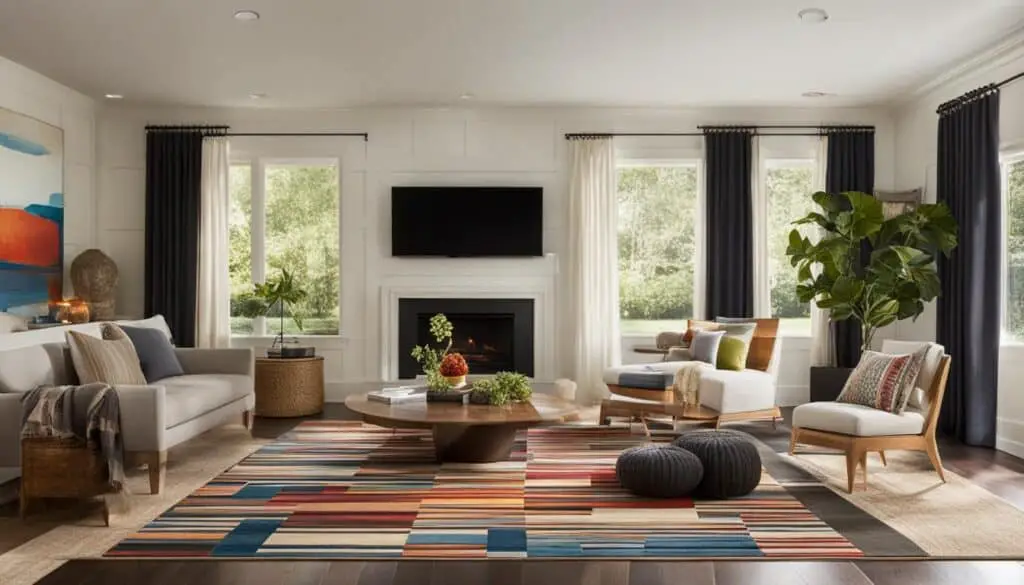 |
| Contrasting Colors | Use trim and battens in contrasting colors to create a bold and striking visual impact. | |
| Arched Details | Add elegance and sophistication to your board and batten design by incorporating arched trim details. |
Conclusion
Throughout this comprehensive style guide, we have explored the beauty and versatility of board and batten and its ability to elevate the aesthetic of your home. From its historical significance to modern adaptations, design principles, DIY installation basics, and tips for choosing the right materials, you now have all the information you need to transform your home with board and batten.
By incorporating board and batten into your interior and exterior design, you can create a timeless and visually appealing space. The vertical lines of board and batten bring a sense of elegance and sophistication to any room, while the choice of materials allows for customization and creative expression.
With the step-by-step tutorials provided in this guide, you have gained the confidence to embark on your own board and batten projects, enhancing your home’s aesthetic and increasing its value. Whether you choose to install board and batten siding or create a feature wall, the possibilities are endless.
In conclusion, board and batten offers a unique opportunity to elevate your home’s aesthetic and make a lasting impression. By incorporating this timeless style into your design, you can create a home that reflects your personal taste and showcases your attention to detail. So go ahead, embrace the charm of board and batten and embark on your own home improvement journey.
FAQ
What is board and batten?
Board and batten is a style of siding or interior wall treatment where wide vertical boards are installed, and narrow strips (battens) are placed over the seams between the boards.
What is the historical significance of board and batten?
Board and batten has a rich history and was originally used as a practical siding option to protect buildings from the elements. It has since evolved into a popular design trend due to its timeless appeal.
How can board and batten enhance the aesthetic of my home?
The vertical lines created by board and batten add visual interest and can give the illusion of height. Choosing the right materials and colors can further enhance the overall design of your home.
Can I install board and batten myself?
Yes, board and batten can be a DIY project. With proper planning, measuring, and installation techniques, you can successfully create a board and batten wall or add board and batten siding to your home’s exterior.
What materials should I use for board and batten?
You can use wood or MDF strips for board and batten. It is important to select materials of the optimal width and quality for a professional-looking finish.
How do I create a board and batten wall?
To create a board and batten wall, you need to plan your design, measure and draw the layout, and carefully install the boards and battens. Proper techniques and considerations for textured walls will help you achieve a smooth finish.
Can board and batten be used as exterior siding?
Yes, board and batten can be used as a durable and visually appealing option for exterior siding. It adds texture and character to your home’s facade while protecting it from the elements.
What are the different material options for board and batten?
You can choose from various materials such as wood, vinyl, or fiber cement for board and batten. Each material has its own durability and cost-effectiveness factors to consider.
How can board and batten enhance my home’s curb appeal?
The addition of board and batten siding or architectural details can significantly enhance your home’s curb appeal by adding texture, depth, and visual interest to the exterior.
How do I maintain my board and batten addition?
Proper maintenance involves caulking any gaps, applying wood filler to imperfections, and ensuring a durable finish that withstands weather and wear over time.
Can board and batten be incorporated into different home styles?
Yes, board and batten is versatile and can be incorporated into various home styles. It is commonly used in modern farmhouse design as well as traditional applications.
How do I choose color schemes for my board and batten features?
You can choose color schemes that express your individual style or opt for complementary colors to create a cohesive look. Creating contrast can also add visual interest to your design.
What are the finishing touches for board and batten design?
Trim and battens can be used to create decorative effects, while lighting and hardware can further enhance the overall look of your board and batten design.

